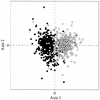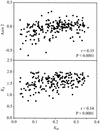Codon usage in Chlamydia trachomatis is the result of strand-specific mutational biases and a complex pattern of selective forces
- PMID: 10773076
- PMCID: PMC105376
- DOI: 10.1093/nar/28.10.2084
Codon usage in Chlamydia trachomatis is the result of strand-specific mutational biases and a complex pattern of selective forces
Abstract
The patterns of synonymous codon choices of the completely sequenced genome of the bacterium Chlamydia trachomatis were analysed. We found that the most important source of variation among the genes results from whether the sequence is located on the leading or lagging strand of replication, resulting in an over representation of G or C, respectively. This can be explained by different mutational biases associated to the different enzymes that replicate each strand. Next we found that most highly expressed sequences are located on the leading strand of replication. From this result, replicational-transcriptional selection can be invoked. Then, when the genes located on the leading strand are studied separately, the correspondence analysis detects a principal trend which discriminates between lowly and highly expressed sequences, the latter displaying a different codon usage pattern than the former, suggesting selection for translation, which is reinforced by the fact that Ks values between orthologous sequences from C. trachomatis and Chlamydia pneumoniae are much smaller in highly expressed genes. Finally, synonymous codon choices appear to be influenced by the hydropathy of each encoded protein and by the degree of amino acid conservation. Therefore, synonymous codon usage in C.trachomatis seems to be the result of a very complex balance among different factors, which rises the problem of whether the forces driving codon usage patterns among microorganisms are rather more complex than generally accepted.
Figures



Similar articles
-
Synonymous codon usage in environmental chlamydia UWE25 reflects an evolutional divergence from pathogenic chlamydiae.Gene. 2006 Mar 1;368:117-25. doi: 10.1016/j.gene.2005.10.035. Epub 2005 Dec 27. Gene. 2006. PMID: 16380221
-
Codon usages of genes on chromosome, and surprisingly, genes in plasmid are primarily affected by strand-specific mutational biases in Lawsonia intracellularis.DNA Res. 2009 Apr;16(2):91-104. doi: 10.1093/dnares/dsp001. Epub 2009 Feb 15. DNA Res. 2009. PMID: 19221094 Free PMC article.
-
[Analysis of factors shaping S. pneumoniae codon usage].Yi Chuan Xue Bao. 2002;29(8):747-52. Yi Chuan Xue Bao. 2002. PMID: 12200868 Chinese.
-
Synonymous codon usage in bacteria.Curr Issues Mol Biol. 2001 Oct;3(4):91-7. Curr Issues Mol Biol. 2001. PMID: 11719972 Review.
-
[Strong strand specific composition bias-a genomic character of some obligate parasites or symbionts].Yi Chuan. 2011 Oct;33(10):1039-47. doi: 10.3724/sp.j.1005.2011.01039. Yi Chuan. 2011. PMID: 21993278 Review. Chinese.
Cited by
-
The alternative translational profile that underlies the immune-evasive state of persistence in Chlamydiaceae exploits differential tryptophan contents of the protein repertoire.Microbiol Mol Biol Rev. 2012 Jun;76(2):405-43. doi: 10.1128/MMBR.05013-11. Microbiol Mol Biol Rev. 2012. PMID: 22688818 Free PMC article. Review.
-
An analysis of codon utilization patterns in the chloroplast genomes of three species of Coffea.BMC Genom Data. 2023 Aug 9;24(1):42. doi: 10.1186/s12863-023-01143-4. BMC Genom Data. 2023. PMID: 37558997 Free PMC article.
-
Comparative chloroplast genomes provided insights into the evolution and species identification on the Datureae plants.Front Plant Sci. 2023 Oct 24;14:1270052. doi: 10.3389/fpls.2023.1270052. eCollection 2023. Front Plant Sci. 2023. PMID: 37941675 Free PMC article.
-
Measure of synonymous codon usage diversity among genes in bacteria.BMC Bioinformatics. 2009 Jun 1;10:167. doi: 10.1186/1471-2105-10-167. BMC Bioinformatics. 2009. PMID: 19480720 Free PMC article.
-
Codon Usage Pattern of Genes Involved in Central Nervous System.Mol Neurobiol. 2019 Mar;56(3):1737-1748. doi: 10.1007/s12035-018-1173-y. Epub 2018 Jun 19. Mol Neurobiol. 2019. PMID: 29922982
References
MeSH terms
Substances
LinkOut - more resources
Full Text Sources

